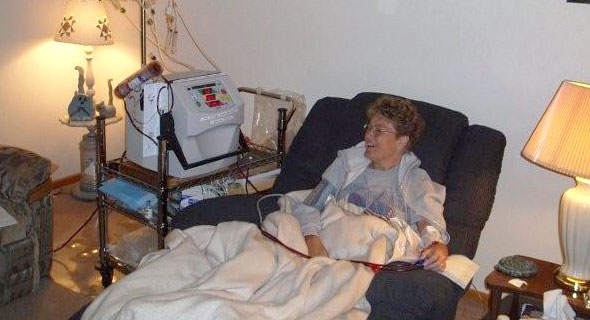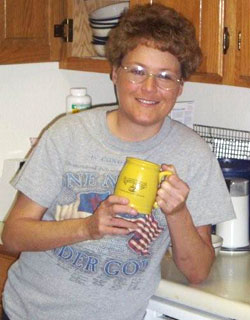
About Penny
| Treatment Type | Daily Home Hemodialysis |
| Gender | Female |
| Age | 50s |
| Marital Status | Married |
| Kids | Yes |
| Work Status | Unknown |
| Race | White |
| Pets | No |
| Cause | Diabetes |
| Travel | No |
| Poor Vision | No |
Penny, who has type 1 diabetes, had preeclampsia when she was pregnant. She learned that she had kidney disease in 1991, after the birth of her daughter. Over the next 4 years, tests showed protein in her urine, and in 1995, she went on the transplant list. Just 2 weeks later, she became the first person in Oklahoma to have a kidney/pancreas transplant. "I was still at 24% kidney function, but they wanted someone who was in good shape so my odds of doing well would be better," explains Penny. The transplant was a success!
A move brings changes
Ten years later, the Air Force moved Penny's family to Washington. She started to have toxic lab results and lost her kidney to chronic rejection in December, 2005. "I started in-center hemodialysis (HD) right away, but after 6 months just didn't feel any healthier," says Penny. "I only weighed 85 pounds and had no appetite or energy." A year after starting in-center HD, Penny lost her pancreas, too.
Penny's doctors at the University of Washington told her that if she didn't receive a kidney in the next 2 years, she would not survive. "In-center HD was taking a toll on my body. But, I was told that I was too small to live through a transplant, so I could not be put on the list."
The toll of in-center HD also affected Penny's daily life. She had a hard time home schooling her daughter, now 16. "Home schooling is an all day process, like a job," says Penny. "I found that I couldn't think straight and was tired all the time. My 19-year-old son would fill in for me sometimes while I took a nap."
A better option

Penny decided that to get on the transplant list—and survive the wait—she had to take matters into her own hands and "be proactive." She started to look at her options. Her nurse told her that the clinic was starting a home HD program. "I asked her about it and knew right away that it would be a better choice for me and my family," says Penny. "I started training went home with a NxStage machine 3 weeks later."
Penny's husband and two children all trained to take turns helping her. "My husband was stationed overseas for more than 4 months and my kids helped me during that time," recalls Penny. "Overall, there is a lot more independence with home HD. I do 80% of the setup myself, put my needles in, connect the lines, and do all of the paperwork." Penny also feels safer doing dialysis at home. "In the northwest, there are a lot of storms. I feel safer at home if there is a power outage. I can dialyze with a generator or wait and do my treatment the next morning."
Dialyzing 5 days a week for 2 hours and 12 minutes a day had a positive impact on Penny right from the start. "My appetite came back! I wasn't dizzy; I felt normal. Within 6 months, my hemoglobin went up from 7 to 12 and all my labs improved," states Penny. "Plus, I was able to be at home with my husband and kids, which was an emotional boost, as well."
With a new appetite, walking, and weight-lifting, Penny's weight climbed from 85 to 150 pounds. "I was healthy enough to be put on the transplant list and could live a normal life. I now go on 1.5 hour forest hikes every day, and stay active with my family," shares Penny. "I'm really trying to make sure my mind, body, and spirit are ready for the 8-hour transplant surgery."
A good choice
Penny is happy she made the switch. "I made the right move to dialyze at home, and I'm at the point that if I don't get a transplant it's not horrifying. I know I could do really well on home HD for life," she asserts. "Home dialysis may not be for everyone. It requires compliance and a sense of responsibility. But for those who want a tighter grip on the preservation of their own lives, this is the right thing to do."

